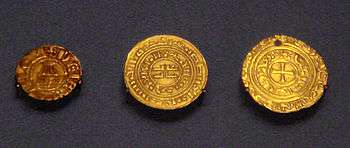Crusades
The Crusades were a series of religious wars initiated, supported, and sometimes directed by the Latin Church in the medieval period. The term refers especially to the Eastern Mediterranean campaigns in the period between 1096 and 1271 that had the objective of recovering the Holy Land from Islamic rule. The term has also been applied to other church-sanctioned campaigns fought to combat paganism and heresy, to resolve conflict among rival Roman Catholic groups, or to gain political and territorial advantage. The difference between these campaigns and other Christian religious conflicts was that they were considered a penitential exercise that brought forgiveness of sins declared by the church. Historians contest the definition of the term "crusade". Some restrict it to only armed pilgrimages to Jerusalem; others include all Catholic military campaigns with a promise of spiritual benefit; all Catholic holy wars; or those with a characteristic of religious fervour.

| Part of a series on |
| Christianity |
|---|
 |
|
|
|
|
|
In 1095, Pope Urban II proclaimed the First Crusade at the Council of Clermont. He encouraged military support for Byzantine Emperor Alexios I against the Seljuk Turks and an armed pilgrimage to Jerusalem. Across all social strata in western Europe there was an enthusiastic popular response. Volunteers took a public vow to join the crusade. Historians now debate the combination of their motivations, which included the prospect of mass ascension into Heaven at Jerusalem, satisfying feudal obligations, opportunities for renown, and economic and political advantage. Initial successes established four Crusader states in the Near East: the County of Edessa; the Principality of Antioch; the Kingdom of Jerusalem; and the County of Tripoli. The crusader presence remained in the region in some form until the city of Acre fell in 1291, leading to the rapid loss of all remaining territory in the Levant. After this, there were no further crusades to recover the Holy Land.
Proclaimed a crusade in 1123, the struggle between the Christians and Muslims in the Iberian Peninsula was called the Reconquista by Christians, and only ended in 1492 with the fall of the Muslim Emirate of Granada. From 1147 campaigns in Northern Europe against pagan tribes were considered crusades. In 1199 Pope Innocent III began the practice of proclaiming political crusades against Christian heretics. In the 13th century, crusading was used against the Cathars in Languedoc and against Bosnia; this practice continued against the Waldensians in Savoy and the Hussites in Bohemia in the 15th century and against Protestants in the 16th. From the mid-14th century, crusading rhetoric was used in response to the rise of the Ottoman Empire, only ending in 1699 with the War of the Holy League.
Terminology
In modern historiography, the term "crusade" first referred to military expeditions undertaken by European Christians in the 11th, 12th, and 13th centuries to the Holy Land. The conflicts to which the term is applied has been extended to include other campaigns initiated, supported and sometimes directed by the Roman Catholic Church against pagans, heretics or for alleged religious ends.[1] These differed from other Christian religious wars in that they were considered a penitential exercise, and so earned participants forgiveness for all confessed sins.[2] The term's usage can create a misleading impression of coherence, particularly regarding the early crusades, and the definition is a matter of historiographical debate among contemporary historians.[3][4][5]
At the time of the First Crusade, iter, "journey", and peregrinatio, "pilgrimage" were used for the campaign. Crusader terminology remained largely indistinguishable from that of Christian pilgrimage during the 12th century. Only at the end of the century was a specific language of crusading adopted in the form of crucesignatus—"one signed by the cross"—for a crusader. This led to the French croisade—the way of the cross.[3] By the mid 13th century the cross became the major descriptor of the crusades with crux transmarina—"the cross overseas"—used for crusades in the eastern Mediterranean, and crux cismarina—"the cross this side of the sea"—for those in Europe.[6][7] The modern English "crusade" dates to the early 1700s.[8]
The Arabic word for struggle or contest, particularly one for the propagation of Islam—jihād—was used for a religious war of Muslims against unbelievers, and it was believed by some Muslims that the Quran and Hadith made this a duty.[9] "Franks" and "Latins" were used by the peoples of the Near East during the crusades for western Europeans, distinguishing them from the Byzantine Christians who were known as "Greeks".[10][11] "Saracen" was used for an Arab Muslim, derived from a Greek and Roman name for the nomadic peoples of the Syro-Arabian desert.[12] Crusader sources used the term "Syrians" to describe Arabic speaking Christians who were members of the Greek Orthodox Church, and "Jacobites" for those who were members of the Syrian Orthodox Church.[13] The Crusader states of Syria and Palestine were known as the "Outremer" from the French outre-mer, or "the land beyond the sea".[14]
Background
Historical
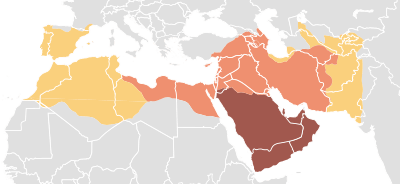
Christianity was adopted by the Roman Empire in Late Antiquity and Constantinople was founded by the first Christian Roman Emperor, Constantine the Great, in 324. The city developed into the largest in the Christian world, while the Western Roman Empire collapsed at the end of the 5th century. The city and the Eastern Roman Empire are more generally known as Byzantium, the name of the older Greek city it replaced.[15] By the end of the 11th century the period of Islamic Arab territorial expansion had been over for centuries. Its remoteness from focus of Islamic power struggles enabled relative peace and prosperity for the Holy Land in Syria and Palestine. The conflict in the Iberian peninsula was the only location where Muslim-Western European contact was more than minimal.[16]
The Byzantine Empire and the Islamic world were long standing centres of wealth, culture and military power. They viewed Western Europe as a backwater that presented little organised threat.[17] The Byzantine Emperor Basil II had extended territorial recovery to its furthest extent in 1025. The Empire's frontiers stretched east to Iran. It controlled Bulgaria, much of southern Italy and suppressed piracy in the Mediterranean Sea. The Empire's relationships with its Islamic neighbours were no more quarrelsome than its relationships with the Slavs or the Western Christians. The Normans in Italy; to the north Pechenegs, Serbs and Cumans; and Seljuk Turks in the east all competed with the Empire and the emperors recruited mercenaries—even on occasions from their enemies—to meet this challenge.[18]
After the foundation of the Islamic religion by Muhammad in the 7th century, Muslim Arabs conquered territory from the Indus in the east, and across North Africa and Southern France to the Iberian Peninsula in the West, before political and religious fragmentation halted this expansion. Syria, Egypt, and North Africa were taken from the Byzantine Empire. The emergance of Shia Islam—the belief system that only descendants of Muhammad's cousin and son-in-law, Ali, and daughter, Fatimah, could lawfully be caliph— had led to a split with Sunni Islam on theology, ritual and law. Muslim Iberia was an independent state in modern Spain and Portugal from the 8th century. The Shi'ite Fatimid dynasty ruled North Africa, swathes of Western Asia including Jerusalem, Damascus and parts of the Mediterranean coastline from 969.[19] Total submission to Islam from Jews or Christians was not required. As People of the Book or dhimmi they could continue in their faith on payment of a poll tax. In the Near East a minority Muslim elite ruled over indigenous Christians—Greeks, Armenians, Syrians and Copts.[20]
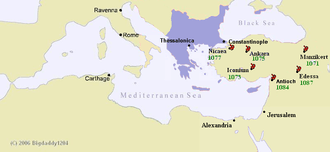
Waves of Turkic migration into the Middle East enjoined Arab and Turkic history from the 9th century. Prisoners from the borderlands of Khurasan and Transoxania were transported to central Islamic lands, converted to Islam and given military training. Known as ghulam or mamluks, it was expected that as slaves they would be more loyal to their masters. In practice it took these Turks only a few decades to progress from being guards, to commanders, governors, dynastic founders and eventually king makers. Examples include the Tulunids in Egypt and Syria (868–905) and the Ikhshidids who followed in Egypt (935–969).[21]
The political situation in Western Asia was further changed by later waves of Turkish migration. In particular, the arrival of the Seljuk Turks in the 10th century. Previously a minor ruling clan from Transoxania, they had recently converted to Islam and migrated into Iran to seek their fortune. In the two decades following their arrival they conquered Iran, Iraq and the Near East. The Seljuks and their followers were from the Sunni Islamic tradition which brought them into conflict in Palestine and Syria with the Shi'ite Fatimids.[22] The Seljuks were nomadic, Turkish speaking and occasionally shamanistic, very different to their sedentary, Arabic speaking subjects. This difference and the governance of territory based on political preference, and competition between independent princes rather than geography, weakened power structures.[23] Byzantine Emperor Romanos IV Diogenes attempted confrontation in 1071 to suppress the Seljuks sporadic raiding leading to defeat at the Battle of Manzikert. Historians once considered this a pivotal event but now Manzikert is regarded as only one further step in the expansion of the Great Seljuk Empire.[24]
The papacy had declined in power and influence to little more than a localised bishopric by the start of the 11th century. But in the period from the 1050s until the 1080s, under the influence of the Gregorian Reform movement, it became increasingly assertive. Conflict with eastern Christians resulted from the doctrine of papal supremacy. The Eastern church viewed the pope as only one of the five patriarchs of the Church, alongside the Patriarchates of Alexandria, Antioch, Constantinople and Jerusalem. In 1054 differences in custom, creed, and practice spurred Pope Leo IX to send a delegation to the Patriarch of Constantinople, which ended in mutual excommunication and an East–West Schism.[25]
Ideology
The use of violence for communal purposes was not alien to early Christians. The evolution of a Christian theology of war was inevitable when Roman citizenship became linked to Christianity and citizens were required to fight against the Empire's enemies. This was supported by the development of a doctrine of holy war dating from the works of the 4th-century theologian Augustine. Augustine maintained that an aggressive war was sinful, but acknowledged a "just war" could be rationalised if it was proclaimed by a legitimate authority such as a king or bishop, was defensive or for the recovery of lands, and a without an excessive degree of violence.[26][27]
Violent acts were commonly used for dispute resolution in Western Europe, and the papacy attempted to mitigate it.[28] Historians, such as Carl Erdmann, thought the Peace and Truce of God movements restricted conflict between Christians from the 10th century; the influence is apparent in Pope Urban II's speeches. But later historians, such as Marcus Bull, assert that the effectiveness was limited and it had died out by the time of the crusades.[29]
Pope Alexander II developed a system of recruitment via oaths for military resourcing that Gregory VII extended across Europe. [30] Christian conflict with Muslims on the southern peripheries of Christendom was sponsored by the Church in the 11th century, including the siege of Barbastro and fighting in Sicily[31] In 1074 Gregory VII planned a display of military power to reinforce the principle of papal sovereignty. His vision of a holy war supporting Byzantium against the Seljuks was the first crusade prototype, but lacked support.[32] Theologian Anselm of Lucca took the decisive step towards an authentic crusader ideology, stating that fighting for legitimate purposes could result in the remission of sins.[33]
The first crusade was advocated by Urban II at the Council of Clermont in 1095, promising absolution for the participants' sins.[34] An equivalence was created between crusades for the Holy Land and the Reconquista by Calixtus II in 1123. During the period of the Second Crusade Eugenius III was persuaded by the Cistercian abbot, Bernard of Clairvaux, that the German's conquest of the pagan Slavs was also comparable.[35] The 1146 papal bull Divina dispensatione declared pagan conversion was a goal worthy of crusade.[36] Papal protection, penance and salvation for those killed was extended to participants in the suppression of heretical sects in 1179 during the Third Council of the Lateran.[37]
Elected pope in 1198, Innocent III reshaped the ideology and practice of crusading. He emphasised crusader oaths and penitence, and clarified that the absolution of sins was a gift from God, rather than a reward for the crusaders' sufferings. Taxation to fund crusading was introduced and donation encouraged.[38][39] In 1199 he was the first pope to deploy the conceptual and legal apparatus developed for crusading to enforce papal rights. With his 1213 bull Quia maior he appealled to all Christians, not just the nobility, offering the possibility of vow redemption without crusading. This set a precedent for trading in spiritual rewards, a practice that scandalised devout Christians and later became one of the causes of the 16th-century Protestant Reformation.[40][41] From the 1220s crusader privileges were regularly granted to those who fought against heretics, schismatics or Christians the papacy considered non-conformist.[42] When Frederick II's army threatened Rome, Gregory IX used crusading terminology. Rome was seen as the Patrimony of Saint Peter, and canon law regarded crusades as defensive wars to protect theoretical Christian territory.[43]
Innocent IV rationalised crusading ideology on the basis of the Christians' right to ownership. He acknowledged Muslims' land ownership, but emphasised that this was subject to Christ's authority.[44] In the 16th century the rivalry between Catholic monarchs prevented anti-Protestant crusades but individual military actions were rewarded with crusader privileges, including Irish Catholic rebellions against English Protestant rule and the Spanish Armada's attack on Queen Elizabeth I and England.[45]
Causes and precursors
The First Crusade was an unexpected event for contemporary chroniclers, but historical analysis demonstrates it had its roots in developments earlier in the 11th century. Clerics and laity increasingly recognised Jerusalem as worthy of penitential pilgrimage. In 1071, Jerusalem was captured by the Turkish warlord Atsiz, who seized most of Syria and Palestine as part of the expansion of the Seljuk Turks throughout the Middle East. The Seljuk hold on the city was weak and returning pilgrims reported difficulties and the oppression of Christians. Byzantine desire for military aid converged with increasing willingness of the western nobility to accept papal military direction.[46][47]
The desire of Christians for a more effective Church was evident in increased piety. Pilgrimage to the Holy Land expanded after safer routes through Hungary developed from 1000. There was an increasingly articulate piety within the knighthood and the developing devotional and penitential practises of the aristocracy created a fertile ground for crusading appeals.[30] Crusaders' motivations may never be understood. One factor may have been spiritual – a desire for penance through warfare. The historian Georges Duby's explanation was that crusades offered economic advancement and social status for younger, landless sons of the aristocracy. This has been challenged by other academics because it does not account for the wider kinship groups in Germany and Southern France. The anonymous Gesta Francorum talks about the economic attraction of gaining "great booty". This was true to an extent, but the rewards often did not include the seizing of land, as fewer crusaders settled than returned. Another explanation was adventure and an enjoyment of warfare, but the deprivations the crusaders experienced and the costs they incurred weigh against this. One sociological explanation was that crusaders had no choice as they were embedded in extended patronage systems and obliged to follow their feudal lords.[48]
From 1092 the status quo in the Middle East disintegrated following the death of the vizier and effective ruler of the Seljuk Empire, Nizam al-Mulk. This was closely followed by the deaths of the Seljuk Sultan Malik-Shah and the Fatimid khalif, Al-Mustansir Billah. The Islamic historian Carole Hillenbrand has described this as analogous to the fall of the Iron Curtain in 1989 with the phrase "familiar political entities gave way to disorientation and disunity".[49] The confusion and division meant the Islamic world disregarded the world beyond; this made it vulnerable to, and surprised by, the First Crusade.[50]
In the eastern Mediterranean
First Crusade and aftermath

In 1095 the Byzantine emperor, Alexios I Komnenos, requested military support from the Council of Piacenza for the fight with the Seljuk Turks. Later that year, at the Council of Clermont, Pope Urban supported this and exhorted war.[51] Thousands of predominantly poor Christians, led by the French priest Peter the Hermit, formed the first response known as the People's Crusade. Passing through Germany they indulged in wide-ranging anti-Jewish activities and massacres. On leaving Byzantine-controlled territory in Anatolia they were annihilated in a Turkish ambush at the Battle of Civetot in October 1096.[52]
They were followed by independent military contingents in loose, fluid arrangements based on bonds of lordship, family, ethnicity and language led by members of the high nobility. Foremost were five princes: Count Raymond of Toulouse; two Normans from southern Italy—Bohemond of Taranto and his nephew Tancred—Godfrey of Bouillon; and his brother Baldwin who led a force from Lotharingia, and Germany. They were joined by a northern French army led by Robert Curthose; Count Stephen of Blois; and Count Robert of Flanders. The army may have numbered 100,000 including non-combatant. They travelled east by land and were cautiously welcomed to Byzantium by Alexios late in 1096.[53] He made them promise to return all recovered Byzantine territory and that their first objective should be Nicaea. While the Seljuk Sultan of Rûm, Kilij Arslan, was away resolving a dispute a Frankish siege and Byzantine naval assault captured the city in June 1097. The crusade then embarked on an arduous march across Anatolia, suffering starvation, thirst and disease. The crusaders gained experience in countering the Turkish tactics of employing lightly armoured mounted archers at the Battle of Dorylaeum. They also developed links with local Armenians. Baldwin left with a small force to establish the County of Edessa, the first Crusader state, early in 1098.[54]
In June 1098 the crusaders gained entry to Antioch after an eight-month siege, massacring most inhabitants, including local Christians. Kerbogha, the Atabeg of Mosul, led a relief force to the city, but Bohemond repulsed him. There was a delay of months while the crusaders decided who would keep the city. This ended on the news that the Fatimid Egyptians had taken Jerusalem from the Seljuks. Despite his promise to Alexios, Bohemond retained Antioch and remained while Raymond led the army along the coast to Jerusalem.[55] Support transported by the Genoese to Jaffa tilted the balance at the siege of Jerusalem, which fell to the Crusaders. They massacred the inhabitants and pillaged the city. Historians believe that contemporary accounts of the numbers killed were exaggerated, but the narrative of massacre reinforced the crusaders' reputation for barbarism.[56] Godfrey secured the Frankish position by defeating an Egyptian force at the Battle of Ascalon.[57]
Many crusaders now considered their pilgrimage complete and returned to Europe. Only 300 knights and 2,000 infantry remained to defend Palestine. The support of troops from Lorraine enabled Godfrey, over the claims of Raymond, to take the position of Defender of the Holy Sepulchre. A year later the Lorrainers foiled an attempt by Dagobert of Pisa, the papal legate, to make Jerusalem a theocracy on Godfrey's death. Baldwin was chosen as the first Latin king.[58] Bohemond returned to Europe to fight the Byzantines from Italy, but his 1108 expedition ended in failure. Raymond's successors captured the city of Tripoli after his death, with the support of the Genoese. [59] Relations between Edessa and Antioch were variable: they fought together in the crusader defeat at the Battle of Harran; but the Antiocheans claimed suzerainty and attempted to block the return of Count Baldwin—later king of Jerusalem—from his captivity after the battle.[60] The Franks engaged in Near East politics, with Muslims and Christians often fighting on both sides. The expansion of Antioch came to an end in 1119 with a major defeat by the Turks at the Battle of Ager Sanguinis, also known as the Field of Blood.[61]
The limited written evidence available from before 1160 indicates the crusade was barely noticed in the Islamic world. This was probably the result of cultural misunderstanding: the Muslims did not recognise the crusaders as religiously motivated warriors intent on conquest and settlement. They assumed this was the latest in a long line of attacks by Byzantine mercenaries. The Islamic world was divided, with rival rulers in Cairo, Damascus, Aleppo and Baghdad. This gave the crusaders an opportunity for consolidation before a pan-Islamic counter-attack.[62]
Loss of Edessa and the Second Crusade
The rise of Imad al-Din Zengi threatened the Franks. He became Atabeg of Mosul in 1127, expanded his control to Aleppo and in 1144 he conquered Edessa. Two years later Pope Eugenius III called for a second crusade. Bernard of Clairvaux spread the message that the loss was the result of sinfulness. Simultaneously, the anti-Semitic preaching of the Cistercian monk, Rudolf, initiated more massacres of Jews in the Rhineland.[63] This was part of a general increase in crusading activity, including in the Iberian peninsula and northern Europe.[64]
Zengi was murdered in uncertain circumstances. His elder son Sayf ad-Din succeeded him as atabeg of Mosul while a younger son Nur ad-Din succeeded in Aleppo.[65] Kings Louis VII of France and Conrad III of Germany were the first ruling monarchs to campaign, but the crusade was not a success. Edessa's destruction made its recovery impossible, and the objectives were unclear. The French held the Byzantines responsible for their defeats by the Seljuks in Anatolia, while the Byzantines reiterated claims on any future territorial gains in northern Syria. The crusaders decided to attack Damascus, breaking a long period of cooperation between Jerusalem and the city's Seljuk rulers. Bad luck, poor tactics and a feeble five-day siege of the city led to argument; the barons of Jerusalem withdrew support and the crusaders retreated before Zengi's sons' army. The chronicler William of Tyre related, and modern historians have concurred, that morale fell, hostility to the Byzantines grew and distrust developed between the newly arrived crusaders and those that had made the region their home.[63]
Rise of Saladin and the Third Crusade
Jerusalem demonstrated an increasing interest in expanding into Egyptian territory after the capture of Ascalon in 1153 opened the road south. A year later Nur ad-Din became the first Muslim in the crusading era to unite Aleppo and Damascus.[66] In 1163 King Amalric of Jerusalem initiated a failed invasion of Egypt which prompted Nur ad-Din to move against the Franks and gain a strategic foothold on the Nile. His Kurdish general, Shirkuh, stormed Egypt and only an Egyptian–Jerusalemite alliance forced his return to Syria. Amalric broke the alliance in a series of ferocious attacks and the Egyptians requested military support. Shirkuh was deployed for a second time, accompanied by his nephew, Yusuf ibn Ayyub, who became known by his Arabic honorific Ṣalāḥ ad-Dīn ("the goodness of faith"), which has been westernised as Saladin. Amalric retreated and the Fatimid caliph appointed the Sunni Shirkuh as vizier. Saladin successfully intrigued to become Shirkuh's successor on his death in 1171. Saladin imprisoned the last Fatimids and established a Sunni regime in Egypt.[67]

Nur al-Din died in 1174 and Saladin became regent for his 11-year-old son, As-Salih Ismail al-Malik. The prince died seven years later, but Saladin had already seized Damascus and much of Syria from his ward's relatives.[68] Overconfidence led to an initial defeat by the Franks at the Battle of Montgisard, but Saladin established a domain stretching from the Nile to the Euphrates through a decade of politics, coercion and low-level military action.[69] In 1186 a life-threatening illness prompted him to make good on his propaganda as the champion of Islam and intensify the campaign against the Franks.[70] King Guy of Jerusalem responded by raising the largest army that Jerusalem had ever put into the field. This force was lured into inhospitable terrain without water and routed by Saladin's forces at the Battle of Hattin. Numerous Christian nobles were taken prisoner, including Guy. Saladin offered them the option of leaving within 40 days or remaining in peace under Islamic rule. Jerusalem and much of Palestine quickly fell to Saladin.[71]
Pope Gregory VIII issued a papal bull titled Audita tremendi, that proposed what became known as the Third Crusade. In August 1189, the freed King Guy attempted to recover Acre by surrounding the city and a long stalemate ensued.[72] Travelling overland Holy Roman Emperor Frederick I died crossing the Saleph River in Cilicia and only a few of his men reached their destination. King Richard I of England travelled by sea. Philip II of France was the first king to arrive at the siege.[73] Richard I conquered Cyprus in transit in response to his sister and his fiancée being take prisoner by the Cypriot ruler, Isaac Komnenos.[74] A year later Richard would facilitate the sale of the island to King Guy for 40,000 bezants as part of the settlement replacing Guy as king of Jerusalem with Conrad of Montferrat.[75]
The arrival of the French and English turned the tide in the conflict, and the Muslim garrison of Acre surrendered. Philip considered his vow fulfilled and returned to France, leaving most of his forces behind. Richard travelled south along the Mediterranean coast and recaptured Jaffa. Twice he advanced to within a day's march of Jerusalem, but lacked the resources to capture and defend the city. A negotiated three-year truce allowed Frankish access to Jerusalem. This was the end of Richard's crusading career and damaged Frankish morale.[76] The Crusader states survived, confined to a narrow coastal strip.[77] Emperor Frederick I's successor, Henry VI, announced a new crusade without papal encouragement in 1195. Henry died before departing on the crusade, but the arrival of the German crusaders prompted Saladin's brother, Al-Adil I to sign a five-year truce in 1198.[78]
Fourth Crusade and the sack of Constantinople
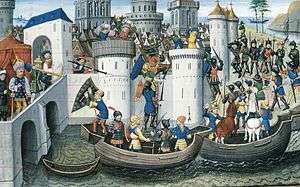
In 1198 the recently elected Pope Innocent III announced a new crusade, organised by three Frenchmen: Theobald of Champagne; Louis of Blois; and Baldwin of Flanders. The Italian Boniface of Montferrat replaced Theobald on the latter's premature death, as the new commander of the campaign. They contracted with the Republic of Venice for the transportation of 30,000 crusaders at a cost of 85,000 marks. However, many choose other embarkation ports and only around 15,000 arrived at Venice. Unable to fully pay the Venetians they accepted two offers. The Doge of Venice Enrico Dandolo proposed that Venice would be repaid with the profits of future conquests beginning with the seizure of the Christian city of Zara. Secondly, the exiled Byzantine prince Alexios Angelos offered 10,000 troops, 200,000 marks and the reunion of the Greek Church with Rome if they toppled his uncle Emperor Alexios III.[79]
Innocent III excommunicated the crusaders for their capture of Zara, but quickly absolved the French. The crusade entered Constantinople, Alexios III fled and was replaced by his nephew. The Greeks resisted the imposition of Alexios IV and harried the crusaders, so he encouraged the crusade to support him until he could fulfil his commitments. This situation ended in a violent anti-Latin revolt and the assassination of Alexios IV. Without ships, supplies or food the crusaders had little option than to take by force what Alexios had promised. The Sack of Constantinople involved three days pillaging churches and killing much of the Greek Orthodox Christian populance.[80] While not unusual behaviour for the time, contemporaries such as Innocent III and Ali ibn al-Athir saw it as an atrocity against centuries of classical and Christian civilisation.[81]
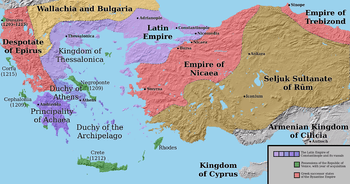
A council of six Venetians and six Franks partitioned the territorial gains, establishing a Latin Empire. Baldwin became Emperor of seven-eights of Constantinople, Thrace, northwest Anatolia and the Aegean Islands. Venice gained a maritime domain including the remaining portion of the city. Boniface received Thessalonika, and his conquest of Attica and Boeotia formed the Duchy of Athens. His vassals, William of Champlitte and Geoffrey of Villehardouin, conquered Morea, establishing the Principality of Achaea. Both Baldwin and Boniface died fighting the Bulgarians, leading the papal legate to release the crusaders from their obligations.[82][83] As many as a fifth of the crusaders continued to Palestine via other routes, including a large Flemish fleet. Joining King Aimery on campaign they forced al-Adil into a six-year truce.[84]
The Latin states established were a fragile patchwork of petty realms threatened by Byzantine successor states—the Despotate of Epirus, the Empire of Nicaea and the Empire of Trebizond. Thessaloniki fell to Epirus in 1224, and Constantinople to Nicaea in 1261. Achaea and Athens survived under the French after the Treaty of Viterbo.[85][86] The Venetians endured a long-standing conflict with the Ottoman Empire until the final possessions were lost in the Seventh Ottoman–Venetian War in the 18th century. This period of Greek history is known as the Frankokratia or Latinokratia ("Frankish or Latin rule") and designates a period when western European Catholics ruled Orthodox Byzantine Greeks.[87]
Conflict with Egypt including the Fifth and Sixth Crusades
There were repeated popular outbursts of ecstatic piety in 13th-century Western Europe such as the Children's Crusade of 1212, when large groups of young adults and children gathered spontaneously in the belief that their innocence would lead to success where others had failed. Few, if any, journeyed to the eastern Mediterranean.[40] Crusading did not resume until 1217. There was no immediate threat and a number of treaties had to expire first. Little was achieved by a Fifth Crusade, primarily raised from Hungary, Germany, Flanders and led by King Andrew II of Hungary and Leopold VI, Duke of Austria. The crusaders attacked Egypt to break the Muslim hold of Jerusalem. Egypt was isolated from the other Islamic power centres, it would be easier to defend and was self-sufficient in food. Damietta was captured but then returned and an eight-year truce agreed after the Franks advancing into Egypt surrendered.[88]
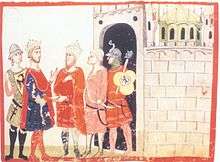
Holy Roman Emperor Frederick II had frequently postponed fulfilling his crusading commitments before he acquired the Kingdom of Jerusalem through marriage in 1225. In 1227 he embarked on crusade, but was forced to abandon it due to illness. This prompted his excommunication by Pope Gregory IX. Despite this Frederick launched a campaign of forceful negotiation that won the Franks most of Jerusalem, a strip of territory linking the city to Acre and an alliance with Al-Kamil, Sultan of Egypt. When the Pope attacked Frederick's Italian possessions he returned to defend them.[89] The kingdom could no longer rely on Frederick's resources and was left dependent on Ayyubid division, the military orders and western aid for survival.[90] The popes' conflict with Frederick left the responsibility for crusading to secular, rather than papal, leadership. The Barons' Crusade was led by King Theobald I of Navarre and when he returned home, by the king of England's brother, Richard of Cornwall. The Franks followed Frederick's tactics of forceful diplomacy and playing rival factions off against each other when Sultan Al-Kamil died and his family fell into disputes over the succession in Egypt and Syria.[91]
The Mongols provided a new military threat to the Christian and Islamic worlds, sweeping west through southern Russia, Poland and Hungary; defeating the Seljuks and threatening the Crusader states. Although predominantly pagan, some Mongols were Nestorian Christians. This gave the papacy hope they might become allies. But when Pope Innocent IV wrote to the Mongols to question their attacks on Christians they replied demanding his total submission.[92] The Mongols displaced a central Asian Turkish people, the Khwarazmian, providing Al-Kamil's son As-Salah with useful allies. The Khwarazmians captured Jerusalem and savagely sacked it. An Egyptian–Khwarazmian army then annihilated a Frankish–Damascene army at the Battle of La Forbie. This was the last time the Franks had the resources to raise a field army in Palestine. As-Salah conquered almost all of the crusaders' mainland territories, confining them to a few coastal towns.[93][94]
Saint Louis, decline and fall
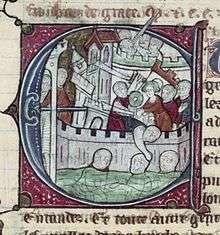
The devout French king, Louis IX, and his brother, Charles I of Anjou, dominated 13th-century politics in the eastern Mediterranean. In 1249 Louis led a crusade attacking Egypt and was defeated at the Battle of Al Mansurah and the crusaders were captured as they retreated. Louis and his nobles were ransomed, other prisoners were given a choice of conversion to Islam or beheading. A ten-year truce was established and Louis remained in Syria until 1254 consolidating the Frankish position. In Egypt a power struggle developed between the Mamluks and the Ayyubid rulers. This led to one of the Mamluk leaders, Qutuz, seizing the sultanate in 1259 and uniting with another Mamluk faction led by Baibars. The Mamluks defeated the Mongols at Ain Jalut before gaining control of Damascus and Aleppo. Qutuz was assassinated and Baibars assumed control.[95][96]
Division in the crusader states led to conflicts such as the War of Saint Sabas. Venice drove the Genoese from Acre to Tyre where they continued trading with the Egyptians.[97] In 1270 Charles turned Louis's new crusade to his advantage by persuading him to attack Tunis. Their army was devastated by disease, and Louis died at Tunis. Prince Edward, the future king of England, and a small retinue arrived too late for the conflict but continued to the Holy Land. Edward survived an assassination attempt, negotiated a ten-year truce, and then returned to manage his affairs in England. This ended the last significant crusading effort in the eastern Mediterranean.[98] The mainland crusader states were finally extinguished with the fall of Tripoli in 1289 and Acre in 1291.[99]
The causes of the decline in crusading and the failure of the crusader states are multi-faceted. The nature of crusades was unsuited to the defence of the Holy Land. Crusaders were on a personal pilgrimage and usually returned when it was completed. Although the ideology of crusading changed over time, crusades continued to be conducted without centralised leadership by short-lived armies led by independently minded potentates, but the crusader states needed large standing armies. Religious fervour was difficult to direct and control even though it enabled significant feats of military endeavour. Political and religious conflict in Europe combined with failed harvests reduced Europe's interest in Jerusalem. The distances involved made the mounting of crusades and the maintenance of communications difficult. It enabled the Islamic world, under the charismatic leadership of Zengi, Nur al-Din, Saladin, the ruthless Baibars and others, to use the logistical advantages of proximity.[100]
Crusader states in the Levant
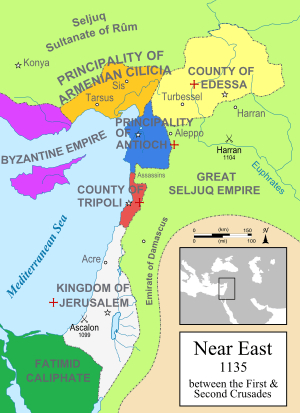
After the First Crusade most of the crusaders considered their personal pilgrimage complete and returned to Europe.[57] Modern research indicates that Muslim and indigenous Christian populations were less integrated than previously thought. Palestinian Christians lived around Jerusalem and in an arc stretching from Jericho and the Jordan to Hebron in the south.[101] Archaeological research on Byzantine churches and Ottoman census records from the 16th century demonstrate that Greek Orthodox communities survived centuries after the fall of the Crusader states. Maronites were concentrated in Tripoli, the Jacobites in Antioch and Edessa. Armenians also lived in the north but communities existed in all major towns. Central areas had a Muslim majority population, predominantly Sunni but with Shi'ite communities in Galilee. Druze Muslims lived in the mountains of Tripoli. The Jewish population resided in coastal towns and some Galilean villages.[102][103] The Frankish population of the Kingdom of Jerusalem was concentrated in three major cities. By the 13th century the population of Acre probably exceeded 60,000, then came Tyre and the capital itself was the smallest of the three with a population somewhere between 20,000 and 30,000.[104] The Latin population of the region peaked at c250,000 with Jerusalem's population numbering c120,000 and the combined total in Tripoli, Antioch and Edessa being broadly comparable.[105] In context, Josiah Russell roughly estimates the population of what he calls "Islamic territory" as 12.5 million in 1000 with the European areas that provided crusaders having a population of 23.7 million. He estimates that by 1200 that these figures had risen to 13.7 million in Islamic territory while the Crusaders' home countries population was 35.6 million. Russell acknowledges that much of Anatolia was Christian or under the Byzantines and "Islamic" areas such as Mosul and Baghdad had significant Christian populations.[106]
The Outremer was a frontier society in which a Frankish elite ruled over of a native population related to the neighbouring communities, many of whom were hostile to the Franks.[107] It was politically and legally stratified with self-governing ethnic communities. Relations between communities were controlled by the Franks.[108] The basic division in society was between Frank and non-Frank, and not between Christian and Muslim. All Franks were considered free men while the native peoples lived like western serfs. The Franks imposed officials in the military, legal and administrative systems using the law and lordships to control the natives. Few Franks could speak more than basic Arabic. Dragomans—interpreters—and ruʾasāʾ—village headmen—were used as mediators. Civil disputes and minor criminality were administered by the native communities, but major offences and those involving Franks were dealt by the Frankish cour des bourgeois. The key differentiator in status and economic position was between urban and rural dwellers. Indigenous Christians could gain higher status and acquire wealth through commerce and industry in towns but few Muslims lived in urban areas except servants.[109]
The Crusader States presented an obstacle to Muslim trade with the west by sea and the land routes from Mesopotamia and Syria to the urban economies of the Nile. However, despite this commerce continued, coastal cities remained maritime outlets for the Islamic hinterland, Eastern wares were exported to Europe in unprecedented volumes. Byzantine-Muslim mercantile growth in the 12th and 13th centuries may have occurred anyway. Western Europe’s population, wealth and the demand for sophisticated Eastern products was booming but it is likely that the Crusades hastened the developments. European fleets expanded, better ships were built, navigation improved and fare paying pilgrims subsidised many voyages. The mainly native agricultural production flourished before the fall of the First Kingdom in 1187, but was negligible afterwards. Italian, Provençal and Catalan merchants monopolised shipping, imports, exports, transportation and banking while the income of the Franks was based on income from estates, market tolls and taxation.[110] Production centred in Antioch, Tripoli, Tyre and Beirut. The Franks exported textiles, glass dyestuffs, olives, wine, sesame oil, sugar and prized Silk and imported clothing and finished goods.[111] The indigenous monetised economic system was adopted with northern Italian and southern French silver European coins, Frankish copper coins minted in Arabic and Byzantine styles, local silver and gold dirhams and dinars. After 1124, Egyptian dinars were copied creating Jerusalem's gold bezant. Following the collapse of the First Kingdom in 1187, trade rather than agriculture increasingly dominated the economy and western coins dominated the coinage and despite some local minting of silver pennies and coppers there is little evidence of systematic attempts to create a unified local currency.[112]
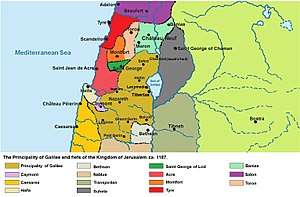
During the near constant warfare in the early decades of the 12th century, the king of Jerusalem's foremost role was leader of the feudal host. They rewarded their followers' loyalty with city incomes rarely granting land and when holdings became vacant, due to the conflict’s high mortality rate this reverted to the crown. The result was that the royal domain of the first five rulers was greater than the combined holdings of the nobility. This gave the rulers of Jerusalem greater internal power than comparative western monarchs but without the necessary administrative machinery to govern a large realm.[113] Baronial dynasties evolved in the second quarter of the century often acting as autonomous rulers. Royal powers were abrogated and effectively governance undertaken locally within the feudatories. Central control that remained was exercised through the Haute Cour or High Court. This was meetings between the king and his tenants in chief. The duty of the vassal to give counsel became a privilege until the legitimacy of the monarch depended on the agreement of the court.[114] The barons have been poorly regarded by both contemporary and modern commentators who note their superficial rhetoric, pedantry and spurious legal justification for political action.[115]
The High Court consisted of the great barons and the king's direct vassals with a quorum of the king and three tenants in chief. The 1162 Assise sur la ligece expanded membership to all the 600+ Franks who paid homage directly to the king. They were joined by the heads of the military orders before the end of the 12th century and the Italian communes in the 13th century.[116] Before the defeat at Hattin in 1187 the laws developed were documented as Assises in Letters of the Holy Sepulchre.[117] The entire body of written law was lost in the fall of Jerusalem leaving a legal system largely based on the custom and memory of the lost legislation. Philip of Novara wrote We know [the laws] rather poorly, for they are known by hearsay and usage...and we think an assize is something we have seen as an assize...in the kingdom of Jerusalem [the barons] made much better use of the laws and acted on them more surely before the land was lost. A myth was created of an idyllic early 12th century legal system that the barons used to reinterpret the Assise sur la ligece that Almalric I intended to strengthen the crown to rather than constrain the monarch’s ability to confiscate feudal fiefs without trial. When the rural fiefs were lost the barons became an urban mercantile class whose knowledge of the law was a valuable skill and career path to higher status.[118] The leaders of the Third Crusade considered the monarchy of Jerusalem of secondary importance. They decided on the grants of land and even granted the throne itself in 1190 and 1192, to Conrad of Montferrat and Henry II, Count of Champagne.[119] Emperor Frederick II married Queen Isabella in 1225 and claimed the throne from her father, the King Regent—John of Brienne. In 1228 Isabella II died after giving birth to a son, Conrad, who through his mother was now legally king of Jerusalem and Frederick's heir.[89] Frederick II left the Holy Land to defend his Italian and German lands beginning a period of absent monarchs from 1225 until 1254. In contrast to Western monarchies with powerful, with centralised bureaucracies government in Jerusalem developed in the opposite direction. Jerusalem’s royalty had title but little power.[120] Magnates fought for regency control with an Italian army led by Frederick's viceroy Richard Filangieri in the War of the Lombards. Tyre, the Hospitallers, the Teutonic Knights and Pisa supported Filangieri. In opposition were the Ibelins, Acre, the Templars and Genoa. For twelve years the rebels held a surrogate parliament in Acre before prevailing in 1242, leading toy a succession of Ibelin and Cypriot regents .[121][122] Centralised government collapsed and the nobility, military orders and Italian communes took the lead. Three Cypriot Lusignan kings succeeded without the resources to recover the lost territory. The title of king was sold to Charles of Anjou who gained power for a short while but never visited the kingdom. [123]
The early crusaders filled ecclesiastical positions left vacant by the Orthodox church and replaced Orthodox bishops with Latin clerics. The Greek Orthodox monks of the Holy Sepulchre were expelled but recalled when the miracle of Easter Fire failed in their absence. Armenians, Copts, Jacobites, Nestorians and Maronites were considered autonomous, retaining their own bishops.[124] Assimilation was prevented by discriminatory laws for Jews and Muslims and an absence of effort by the Franks. Muslims were banned from living in Jerusalem and sexual relationships between Muslims and Christians was punished by mutilation. [125]
Largely based in the ports of Acre, Tyre, Tripoli and Sidon, Italian, Provençal and Catalan communes had distinct cultural characteristics and exerted significant political power. Separate from the Frankish nobles or burgesses, the communes were autonomous political entities closely linked to their hometowns. They monopolised foreign trade and almost all banking and shipping and aggressively extended trade privileges. Despite all efforts, the ports were unable supersede Alexandria and Constantinople as the primary regional commercia centres but the communes did compete with the monarchs and each other for economic advantage. Power derived from the support of the communards' native cities rather than their number, which never reached more than hundreds. By the middle of the 13th century, the rulers of the communes were barely recognised crusader authority and divided Acre into several fortified miniature republics.[126][127]
There were few cultural innovations in the Outremer beyond the establishment of the military orders and the development of tactics and military architecture.[128] John of Ibelin records in around 1170 that the military force of the kingdom of Jerusalem was based on a feudal host of about 647 to 675 heavily armoured knights. Each knight would also provide his own armed retainers. Non-noble light cavalry and infantry were known as serjants and these numbered around 5,025. These numbers were augmented by mercenaries such as the Turcopoles recruited from among the natives. [129] Joshua Prawer estimated that the military orders matched this force in number giving an estimated military strength of 1,200 knights and 10,000 serjants. This was sufficient for territorial gains, but fewer than the required to maintain military domination. This defensive problem was that putting an army into the field required draining castles and cities of every able-bodied fighting man. In the case of a defeat such as at Hattin, no one remained to resist the invaders. The Franks adopted delaying tactics when faced with a superior invading Muslim force, avoiding direct confrontation, retreating to strongholds and waiting for the Muslim army to disperse. Muslim armies were incohesive and seldom campaigned beyond a period between sowing and harvest. It took generations before the Muslims identified that in order to conquer the Crusader states they needed to destroy the Frankish fortresses. This strategic change forced the crusaders away from focussing on the gaining and holding territory but rather on attacking and destroying Egypt, neutralising this regional challenge and gaining the time to improve the kingdom's demographic weaknesses.[130]
In Europe
Reconquista
The disintegration of the Caliphate of Córdoba in southern Spain created the opportunity for the Reconquista, beginning in 1031. The Christian realms had no common identity or shared history based on tribe or ethnicity. As a result, León, Navarre and Catalonia united and divided several times during the 11th and 12th centuries. Although small, all developed an aristocratic military technique.[131] By the time of the Second Crusade the three kingdoms were powerful enough to conquer Islamic territory—Castile, Aragon and Portugal.[132] In 1212 the Spanish were victorious at the Battle of Las Navas de Tolosa with the support of 70,000 foreign combatants who responded to the preaching of Innocent III. Many foreigners deserted because of the tolerance the Spanish demonstrated for the defeated Muslims. For the Spanish, the Reconquista was a war of domination rather than a war of extermination.[133] This contrasted with the treatment of the Christians formerly living under Muslim rule, the Mozarabs. The Roman Rite was relentlessly imposed on them, and the native Christians were absorbed into mainstream Catholicism.[101] Al-Andalus, Islamic Spain, was completely suppressed in 1492 when the Emirate of Granada surrendered. At this point the remaining Muslim and Jewish inhabitants were expelled from the peninsula.[134]
Campaigns against heretics and schismatics
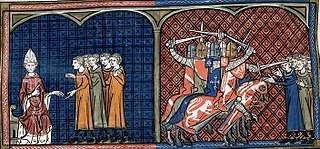
There were modest efforts to suppress a dualistic Christian sect called the Cathars in southern France around 1180.[37] After a thirty-year delay Innocent III proclaimed the Albigensian Crusade, named after the city of Albi, one of the centres of Catharism.[135] This proved that it was more effective waging a war against the heretics' supporters than the heretics themselves. Tolerant feudal lords had their lands confiscated and titles forfeited. In 1212 pressure was exerted on the city of Milan for tolerating Catharism.[136] Two Hungarian invasions of Bosnia, the home of a legendary Cathar anti-pope, were proclaimed crusades in 1234 and 1241. A crusade forced the Stedinger peasants of north-western Germany to pay tithes in 1234.[137] The historian Norman Housley notes the connection between heterodoxy and anti-papalism in Italy. Indulgences were offered to anti-heretical groups such as the Militia of Jesus Christ and the Order of the Blessed Virgin Mary.[138] Anti-Christian crusading declined in the 15th century, the exceptions were the six failed crusades against the religiously radical Hussites in Bohemia and attacks on the Waldensians in Savoy.[45]
Political campaigns in Italy
The Albigensian Crusades established a precedent for popes and the Inquisition to claim their Christian opponents were heretics.[139][140] Innocent III declared the first political crusade against Markward von Annweiler, the regent for Frederick II. Later, when Frederick threatened to take Rome in 1240, Gregory IX used crusading terminology to raise support against him. On Frederick II's death the focus moved to Sicily. In 1263, Pope Urban IV offered crusading indulgences to Charles of Anjou in return for Sicily's conquest. But, these wars had no clear objectives or limitations making them unsuitable for crusading.[43] The 1281 election of a French pope, Martin IV, brought the power of the papacy behind Charles. Charles's preparations for a crusade against Constantinople were foiled by the Byzantine Emperor Michael VIII Palaiologos, who instigated an uprising called the Sicilian Vespers. Instead, Peter III of Aragon was proclaimed king of Sicily, despite his excommunication and an unsuccessful Aragonese Crusade.[141] Political crusading continued against Venice over Ferrara; Louis IV, King of Germany when he marched to Rome for his imperial coronation; and the free companies of mercenaries.[142]
Northern crusades
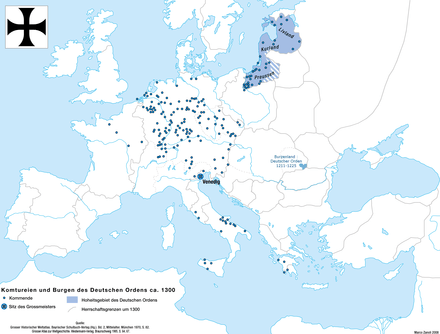
In 1147 Bernard of Clairvaux persuaded Pope Eugenius III that the Germans' and Danes' conflict with the pagan Wends was a holy war analogous to the Reconquista; he urged a crusade until all heathens were baptised or killed. The new crusaders' motivation was primarily economic: the acquisition of new arable lands and serfs; the control of Baltic trade routes; and the abolishment of the Novgorodian merchants' monopoly of the fur trade.[143] From the early 13th century the military orders provided garrisons in the Baltic and defended the German commercial centre, Riga. The Livonian Brothers of the Sword and the Order of Dobrzyń were established by local bishops. The Sword Brothers were notorious for cruelty to pagans and converts alike. The Teutonic Knights were founded during the 1190s in Palestine, but their strong links to Germany diverted efforts from the Holy Land to the Baltic. Between 1229 and 1290, the Teutonic Knights absorbed both the Brothers of the Sword and the Order of Dobrzyń, subjugated most of the Baltic tribes and established a ruthless and exploitative monastic state.[144][145] The Knights invited foreign nobility to join their regular Reisen, or raids, against the last unconquered Baltic people, the Lithuanians. These were fashionable events of chivalric entertainment among young aristocrats. Jogaila, Grand Prince of Lithuania, converted to Catholicism and married Queen Jadwiga of Poland resulting in a united Polish–Lithuanian army routing the Knights at Tannenberg in 1410. The Knights' state survived, from 1466 under Polish suzerainty. Prussia was transformed into a secular duchy in 1525, and Livonia in 1562.[146]
Late medieval and early modern period
The Seljuk Sultanate of Rum fragmented in the late 13th century. The Ottoman Turks, located in north-eastern Anatolia, took advantage of a Byzantine civil war of 1341–1347 and established a strong presence in Europe. They captured the Byzantine fortress at Gallipoli in 1354 and defeated the Serbians at the Battle of Kosovo in 1389, winning control of the Balkans from the Danube to the Gulf of Corinth. This was further confirmed by victory over French crusaders and King Sigismund of Hungary at the Battle of Nicopolis in 1396. Sultan Murad II destroyed a large crusading Serbian and Hungarian force at Varna in 1444 and four years later defeated the Hungarians at Kosovo again.[147][148]
After the fall of Constantinople in 1453 the crusading response was largely symbolic. One example was Duke Phillip of Burgundy's 1454 promotion of a crusade, that never materialised, at the Feast of the Pheasant.[149] The 16th century saw growing rapprochement. The Habsburgs, French, Spanish and Venetians all signed treaties with the Ottomans. King Francis I of France sought allies from all quarters, including from German Protestant princes and Sultan Suleiman the Magnificent.[150] Crusading became chiefly a financial exercise with precedence given to the commercial and political aspects. As the military threat presented by the Turks diminished, anti-Ottoman crusading became obsolete with the Holy League in 1699.[151]
Military orders
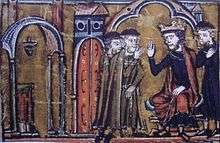
The crusaders' propensity to follow the customs of their Western European homelands meant that there were few innovations developed in the crusader states. Three notable exceptions to this were the military orders, warfare and fortifications.[152] The Knights Hospitaller, formally the Order of Knights of the Hospital of Saint John of Jerusalem, had a medical function in Jerusalem before the First Crusade. The order later adding a martial element and became a much larger military order.[153] In this way knighthood entered the previously monastic and ecclesiastical sphere.[154] The Templars, formally the Poor Fellow-Soldiers of Christ and the Temple of Solomon were founded around 1119 by a small band of knights who dedicated themselves to protecting pilgrims en route to Jerusalem.[155] King Baldwin II granted the order the Al-Aqsa Mosque in 1129 they were formally recognised by the papacy at the 1129 Council of Troyes. Military orders like the Knights Hospitaller and Knights Templar provided Latin Christendom's first professional armies in support of the Kingdom of Jerusalem and the other crusader states.[156]
The Hospitallers and the Templars became supranational organisations as papal support led to rich donations of land and revenue across Europe. This, in turn, led to a steady flow of new recruits and the wealth to maintain multiple fortifications in the crusader states. In time, they developed into autonomous powers in the region.[157] After the fall of Acre the Hospitallers relocated to Cyprus, then ruled Rhodes until the island was taken by the Ottomans in 1522, and Malta until Napoleon captured the island in 1798. The Sovereign Military Order of Malta continues in existence to the present-day.[158] King Philip IV of France probably had financial and political reasons to oppose the Knights Templar, which led to him exerting pressure on Pope Clement V. The Pope responded in 1312 with a series of papal bulls including Vox in excelso and Ad providam that dissolved the order on the alleged and probably false grounds of sodomy, magic and heresy.[159]
Art and architecture
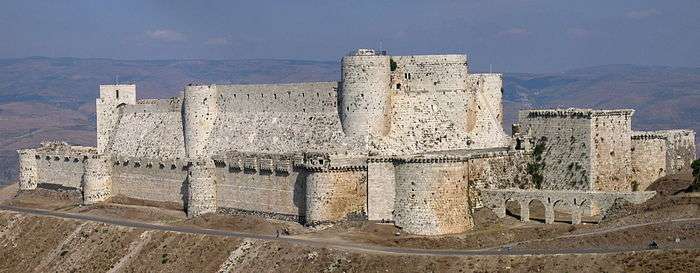
According to the historian Joshua Prawer no major European poet, theologian, scholar or historian settled in the crusader states. Some went on pilgrimage, and this is seen in new imagery and ideas in western poetry. Although they did not migrate east themselves, their output often encouraged others to journey there on pilgrimage.[160]
Historians consider the crusader military architecture of the Middle East to demonstrate a synthesis of the European, Byzantine and Muslim traditions and to be the most original and impressive artistic achievement of the crusades. Castles were a tangible symbol of the dominance of a Latin Christian minority over a largely hostile majority population. They also acted as centres of administration.[161] Modern historiography rejects the 19th-century consensus that Westerners learnt the basis of military architecture from the Near East, as Europe had already experienced rapid development in defensive technology before the First Crusade. Direct contact with Arab fortifications originally constructed by the Byzantines did influence developments in the east, but the lack of documentary evidence means that it remains difficult to differentiate between the importance of this design culture and the constraints of situation. The latter led to the inclusion of oriental design features such as large water reservoirs and the exclusion of occidental features such as moats.[162]
Typically, crusader church design was in the French Romanesque style. This can be seen in the 12th-century rebuilding of the Holy Sepulchre. It retained some of the Byzantine details, but new arches and chapels were built to northern French, Aquitanian and Provençal patterns. There is little trace of any surviving indigenous influence in sculpture, although in the Holy Sepulchre the column capitals of the south facade follow classical Syrian patterns.[163]
In contrast to architecture and sculpture, it is in the area of visual culture that the assimilated nature of the society was demonstrated. Throughout the 12th and 13th centuries the influence of indigenous artists was demonstrated in the decoration of shrines, paintings and the production of illuminated manuscripts. Frankish practitioners borrowed methods from the Byzantines and indigenous artists and iconographical practice leading to a cultural synthesis, illustrated by the Church of the Nativity. Wall mosaics were unknown in the west but in widespread use in the crusader states. Whether this was by indigenous craftsmen or learnt by Frankish ones is unknown, but a distinctive original artistic style evolved.[164]
Manuscripts were produced and illustrated in workshops housing Italian, French, English and local craftsmen leading to a cross-fertilisation of ideas and techniques. An example of this is the Melisende Psalter, created by several hands in a workshop attached to the Holy Sepulchre. This style could have both reflected and influenced the taste of patrons of the arts. But what is seen is an increase in stylised, Byzantine-influenced content. This extended to the production of icons, unknown at the time to the Franks, sometimes in a Frankish style and even of western saints. This is seen as the origin of Italian panel painting.[165] While it is difficult to track illumination of manuscripts and castle design back to their origins, textual sources are simpler. The translations made in Antioch are notable, but they are considered of secondary importance to the works emanating from Muslim Spain and from the hybrid culture of Sicily.[166]
Female involvement
Until the requirement was abolished by Innocent III married men needed to obtain their wives' consent before taking the cross, which was not always readily forthcoming. Muslim and Byzantine observers viewed with disdain the many women who joined the armed pilgrimages, including female fighters. Western chroniclers indicated that female crusaders were wives, merchants, servants and sex workers. Attempts were made to control the women's behaviour in ordinances of 1147 and 1190. Aristocratic women had a significant impact: Ida of Formbach-Ratelnberg led her own force in 1101; Eleanor of Aquitaine conducted her own political strategy; and Margaret of Provence negotiated her husband Louis IX's ransom with an opposing woman—the Egyptian sultana Shajar al-Durr. Misogyny meant that there was male disapproval; chroniclers tell of immorality and Jerome of Prague blamed the failure of the Second Crusade on the presence of women. Even though they often promoted crusading, preachers would typecast them as obstructing recruitment, despite their donations, legacies and vow redemptions. The wives of crusaders shared their plenary indulgences.[167]
Finance
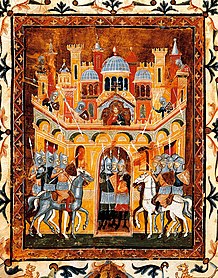
Despite the common misconception concerning deliberate, widespread pillaging the First Crusade, from its onset, was never intended as a greed-ridden escapade; in fact, Pope Urban II, in his speech at the Council of Clermont, urged his acolytes to "rent their lands and collect money for their expenses" rather than relying on the acquired treasures.[169] The Pope, self-depicted as such in his speech, was not driven by avarice and did not condone the pillaging of Christian and Muslim provinces that were to be encountered throughout the journey. That said, plundering did occur.[170] The mob led by Peter the Hermit ransacked Christian villages in Hungary and Greece, and robbed its inhabitants.[171] Numerous Jewish populaces were robbed and, for some, murdered. But the spoils belonging to the Muslims, significantly greater than those of the two aforementioned religious groups, supplied the crusading forces with an abundance of precious goods, and deposits of gold and silver.[170]
For most participants, however, crusading was ruinously expensive and required extensive financial preparation. The prudent crusader, cognizant of both his militant and at-home obligations, endowed his family, if possible, with the requisite coinage before setting out to crusade, taking with him "great bags and chests of money."[172] That said, Fred Cazel noted: "Few crusaders had sufficient cash both to pay their obligations at home and to support themselves decently on a crusade."[173] Those adamant crusaders, unwilling to forego battle, sold their estates, stocks, and valuables to subsidize the journey ahead; and some even borrowed significant funds from kings and princes, from bishops and monasteries, from merchants and craftsmen, from whoever could sustain lending the ample amount.[170]
Legacy
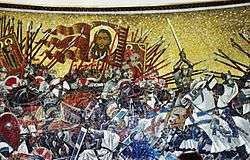
The Crusades created national mythologies, tales of heroism, a few place names, and developed Europe's political topology.[174] Historical parallelism and the tradition of drawing inspiration from the Middle Ages have become keystones of political Islam encouraging ideas of a modern jihad and a centuries-long struggle against Christian states, while secular Arab nationalism highlights the role of western imperialism.[175] Modern Muslim thinkers, politicians and historians have drawn parallels between the crusades and political developments such as the establishment of Israel in 1948.[176] Right-wing circles in the western world have drawn opposing parallels, considering Christianity to be under an Islamic religious and demographic threat that is analogous to the situation at the time of the crusades. Crusader symbols and anti-Islamic rhetoric are presented as an appropriate response, even if only for propaganda purposes. These symbols and rhetoric are used to provide a religious justification and inspiration for a struggle against a religious enemy.[177]
Historiography
Medieval
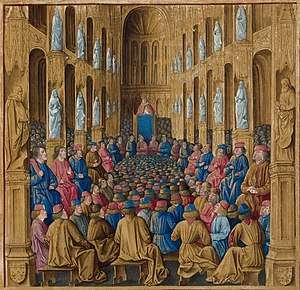
Originally, medieval understanding of the crusades was narrowly focussed on a limited set of interrelated texts, most notably Gesta Francorum which possibly dates from as early as 1099. The Gesta was reworked by Robert of Rheims who created a papalist, northern French template for later works. These all demonstrated a degree of martial advocacy that attributed both success and failure to God's will.[178] This clerical view was soon challenged by vernacular adventure stories based on the work of Albert of Aachen. William of Tyre expanded on Albert's writing in his Historia. Completed by 1184, William's work describes the warrior state that Outremer had become through the tensions between divine providence and humankind.[179] Medieval crusade historiography remained more interested in presenting moralistic lessons than information, extolling the crusades as a moral exemplar and a cultural norm.[180]
Reformation
Attitudes toward the crusades during the Reformation were shaped by confessional debates and the Ottoman expansion. The Protestant martyrologist John Foxe in his History of the Turks (1566) blamed the sins of the Catholic Church for the failure of the crusades. He also condemned the use of crusades against those he considered had maintained the faith, such as the Albigensians and Waldensians. The Lutheran scholar Matthew Dresser (1536–1607) extended this view; the crusaders were lauded for their faith but Urban II's motivation was seen as part of his conflict with Emperor Henry IV. On this view, the crusade was flawed, and the idea of restoring the physical holy places was "detestable superstition".[181] The French Catholic lawyer Étienne Pasquier (1529–1615) was one of the first to number the crusades; he suggested there were six. His work highlights the failures of the crusades and the damage that religious conflict had inflicted on France and the church; it lists victims of papal aggression, sale of indulgences, church abuses, corruption, and conflicts at home.[182]
Enlightenment
Age of Enlightenment philosopher-historians such as David Hume, Voltaire and Edward Gibbon used crusading as a conceptual tool to critique religion, civilisation and cultural mores. For them the positives effects of crusading, such as the increasing liberty that municipalities were able to purchase from feudal lords, were only by-products. This view was then criticised in the 19th century by crusade enthusiasts as being unnecessarily hostile to, and ignorant of, the crusades.[183] Alternatively, Claude Fleury and Gottfried Wilhelm Leibniz proposed that the crusades were one stage in the improvement of European civilisation; that paradigm was further developed by the Rationalists.[184]
The idea that the crusades were an important part of national history and identity continued to evolve. In scholarly literature, the term "holy war" was replaced by the neutral German kreuzzug and French croisade.[185] Gibbon followed Thomas Fuller in dismissing the concept that the crusades were a legitimate defence, as they were disproportionate to the threat presented; Palestine was an objective, not because of reason but because of fanaticism and superstition.[186] William Robertson expanded on Fleury in a new, empirical, objective approach, placing crusading in a narrative of progress towards modernity. The cultural consequences of growth in trade, the rise of the Italian cities and progress are elaborated in his work. In this he influenced his student Walter Scott.[187] Much of the popular understanding of the crusades derives from the 19th century novels of Scott and the French histories by Joseph François Michaud.[188]
Contemporary
In a 2001 article—"The Historiography of the Crusades"—Giles Constable attempted to categorise what is meant by "Crusade" into four areas of contemporary crusade study. His view was that Traditionalists such as Hans Eberhard Mayer are concerned with where the crusades were aimed, Pluralists such as Jonathan Riley-Smith concentrate on how the crusades were organised, Popularists including Paul Alphandery and Etienne Delaruelle focus on the popular groundswells of religious fervour, and Generalists, such as Ernst-Dieter Hehl focus on the phenomenon of Latin holy wars.[4][5] The historian Thomas F. Madden argues that modern tensions are the result of a constructed view of the crusades created by colonial powers in the 19th century and transmitted into Arab nationalism. For him the crusades are a medieval phenomenon in which the crusaders were engaged in a defensive war on behalf of their co-religionists.[189]
Muslim

The Muslim world exhibited little interest in the crusades until the middle of the 19th century. Arabic-speaking Syrian Christians began translating French histories into Arabic, leading to the replacement of the term "wars of the Ifranj" – Franks – with al-hurub al Salabiyya – "wars of the Cross". The Ottoman Turk Namık Kemal published the first modern Saladin biography in 1872. The Jerusalem visit in 1898 of Kaiser Wilhelm prompted further interest, with the Egyptian Sayyid Ali al-Hariri producing the first Arabic history of the crusades. Modern studies can be driven by political motives, such as the hope of learning from the Muslim forces' triumph over their enemies.[190]
See also
References
- "crusades". Oxford English Dictionary (3rd ed.). Oxford University Press. September 2005. (Subscription or UK public library membership required.)
- Tyerman 2019, p. 1.
- Asbridge 2012, p. 40.
- Tyerman 2011, pp. 225–226.
- Constable 2001, pp. 1–22.
- Tyerman 2019, p. 5.
- "Outremer". Oxford English Dictionary (3rd ed.). Oxford University Press. September 2005. (Subscription or UK public library membership required.)
- Tyerman 2011, p. 77.
- "jihad". Oxford English Dictionary (3rd ed.). Oxford University Press. September 2005. (Subscription or UK public library membership required.)
- "Frank". Oxford English Dictionary (3rd ed.). Oxford University Press. September 2005. (Subscription or UK public library membership required.)
- "Latin". Oxford English Dictionary (3rd ed.). Oxford University Press. September 2005. (Subscription or UK public library membership required.)
- "Saracen". Oxford English Dictionary (3rd ed.). Oxford University Press. September 2005. (Subscription or UK public library membership required.)
- Jotischky 2004, p. 141.
- Tyerman 2019, p. 105.
- Asbridge 2012, pp. 5–6.
- Jotischky 2004, p. 40.
- Asbridge 2012, p. 8.
- Jotischky 2004, pp. 42–46.
- Asbridge 2012, pp. 19–20.
- Asbridge 2012, pp. 18–23.
- Holt 2004, pp. 6–7.
- Jotischky 2004, pp. 39–41.
- Tyerman 2019, pp. 43–44.
- Asbridge 2012, p. 27.
- Jotischky 2004, pp. 24–30.
- Tyerman 2019, pp. 14–15.
- Asbridge 2012, pp. 14–15.
- Jotischky 2004, pp. 30–31.
- Jotischky 2004, pp. 30–38.
- Jotischky 2004, p. 31.
- Tyerman 2019, pp. 18–19, 289.
- Asbridge 2012, p. 16.
- Jotischky 2004, pp. 27–28.
- Asbridge 2012, pp. 34,38.
- Jotischky 2004, p. 190.
- Jotischky 2004, pp. 199–202.
- Tyerman 2019, p. 344.
- Tyerman 2019, pp. 235–237.
- Asbridge 2012, pp. 524–525.
- Asbridge 2012, pp. 533–535.
- Tyerman 2019, pp. 238–239.
- Tyerman 2019, p. 336.
- Jotischky 2004, pp. 195–198.
- Jotischky 2004, pp. 256–257.
- Tyerman 2019, pp. 358–359.
- Asbridge 2012, p. 28.
- Jotischky 2004, p. 46.
- Jotischky 2004, pp. 12–13,15–16.
- Hillenbrand 1999, p. 33.
- Jotischky 2004, p. 41.
- Jotischky 2004, p. 30.
- Asbridge 2012, p. 41.
- Asbridge 2012, pp. 43–48.
- Asbridge 2012, pp. 50–61.
- Asbridge 2012, pp. 72–82,89–96.
- Asbridge 2012, pp. 96–103.
- Asbridge 2012, pp. 104–106.
- Tyerman 2019, p. 116.
- Asbridge 2012, pp. 142–149.
- Jotischky 2004, p. 70.
- Jotischky 2004, pp. 67–68.
- Asbridge 2012, pp. 111–114.
- Jotischky 2004, pp. 84–91.
- Asbridge 2012, pp. 201–218.
- Asbridge 2012, pp. 228–229.
- Asbridge 2012, pp. 250–251.
- Asbridge 2012, pp. 268–280.
- Asbridge 2012, pp. 285–298,317.
- Asbridge 2012, pp. 307–308,322.
- Asbridge 2012, pp. 333–336.
- Asbridge 2012, pp. 343–357.
- Asbridge 2012, pp. 398–405.
- Tyerman 2019, pp. 210–211.
- Asbridge 2012, pp. 429–430.
- Asbridge 2012, p. 494.
- Asbridge 2012, pp. 443–513.
- Asbridge 2012, p. 513.
- Tyerman 2019, pp. 224–225.
- Tyerman 2019, pp. 240–242.
- Asbridge 2012, p. 530.
- Tyerman 2019, p. 250.
- Jotischky 2004, pp. 206–208.
- Lock 2006, pp. 232–233,436.
- Tyerman 2019, pp. 250–251.
- Jotischky 2004, pp. 208–210.
- Lock 2006, pp. 125,133,337,436–437.
- Jotischky 2004, pp. 206–212.
- Jotischky 2004, pp. 214–218,236.
- Asbridge 2012, pp. 563–571.
- Asbridge 2012, p. 574.
- Asbridge 2012, p. 573.
- Jotischky 2004, pp. 237–238.
- Asbridge 2012, pp. 574–576.
- Jotischky 2004, p. 231.
- Asbridge 2012, pp. 583–607,615–620.
- Tyerman 2019, pp. 276–277.
- Asbridge 2012, pp. 627–628.
- Asbridge 2012, pp. 640–644.
- Asbridge 2012, p. 656.
- Asbridge 2012, pp. 660–664.
- Jotischky 2004, p. 131.
- Jotischky 2004, pp. 131–132.
- Prawer 1972, pp. 49,51.
- Prawer 1972, p. 82.
- Prawer 1972, p. 396.
- Russell 1985, p. 298.
- Jotischky 2004, pp. 17–19.
- Tyerman 2019, p. 127.
- Jotischky 2004, pp. 128–130.
- Prawer 1972, pp. 352–354.
- Prawer 1972, pp. 396–397, 392–393.
- Tyerman 2019, pp. 120–121.
- Prawer 1972, pp. 104–105.
- Prawer 1972, p. 112.
- Jotischky 2004, p. 226.
- Prawer 1972, pp. 112–117.
- Prawer 1972, p. 122.
- Jotischky 2004, p. 228.
- Prawer 1972, pp. 107–108.
- Prawer 1972, p. 104.
- Jotischky 2004, p. 229.
- Tyerman 2019, p. 268.
- Prawer 1972, pp. 108–109.
- Jotischky 2004, pp. 134–143.
- Jotischky 2004, pp. 127–129.
- Prawer 1972, pp. 85–93.
- Jotischky 2004, pp. 151–152.
- Prawer 1972, p. 252.
- Jotischky 2004, p. 134.
- Prawer 1972, pp. 327–333, 340–341.
- Jotischky 2004, pp. 183–184.
- Jotischky 2004, p. 188.
- Jotischky 2004, p. 191.
- Lock 2006, pp. 212–213.
- Lock 2006, p. 163n.
- Jotischky 2004, p. 193.
- Lock 2006, p. 172.
- Jotischky 2004, pp. 193–196.
- Jotischky 2004, pp. 193–195.
- Lock 2006, pp. 147,155–156.
- Jotischky 2004, p. 198.
- Tyerman 2019, pp. 353–354.
- Jotischky 2004, pp. 199–205.
- Jotischky 2004, pp. 202–203.
- Tyerman 2019, pp. 315–327.
- Tyerman 2019, pp. 328–333.
- Tyerman 2019, pp. 397–398.
- Jotischky 2004, p. 257.
- Jotischky 2004, p. 260.
- Tyerman 2019, pp. 406–408.
- Tyerman 2019, pp. 9,420–421.
- Prawer 1972, p. 252
- Asbridge 2012, p. 169
- Prawer 1972, p. 253
- Asbridge 2012, p. 168
- Tyerman 2019, pp. 152–155.
- Asbridge 2012, pp. 169–170
- Tyerman 2019, pp. 380–383,419,441.
- Davies 1997, p. 359
- Prawer 1972, p. 468.
- Prawer 1972, pp. 280–281.
- Prawer 1972, pp. 295–296.
- Jotischky 2004, p. 146.
- Jotischky 2004, pp. 145–146.
- Jotischky 2004, pp. 147–149.
- Asbridge 2012, pp. 667–668.
- Tyerman 2019, pp. 10–12.
- "Crusades - The siege of Jerusalem". Encyclopedia Britannica. Retrieved 2020-07-06.
- "Internet History Sourcebooks Project". sourcebooks.fordham.edu. Retrieved 2020-07-06.
- Setton, Kenneth M. (1985). A History of the Crusades: The Impact of the Crusades on the Near East (PDF). Univ of Wisconsin Press. ISBN 978-0-299-09144-6.
- Perdios, Stanley, "peter the hermit: straddling the boundaries of lordship, millennialism, and heresy" (2012). Graduate Theses and Dissertations. 12431.
- Crawford, Paul F. (8 October 2014). "Four Myths about the Crusades". Intercollegiate Studies Institute: Think. Live Free. Retrieved 2020-07-06.
- Fred Cazel, “Financing the Crusades,” in A History of the Crusades, ed. Kenneth Setton, vol. 6 (Madison, WI: University of Wisconsin Press, 1989), 117.
- Tyerman 2019, p. 468.
- Asbridge 2012, pp. 675–680.
- Asbridge 2012, pp. 674–675.
- Koch 2017, p. 1.
- Tyerman 2011, pp. 8–12.
- Tyerman 2011, pp. 16–17.
- Tyerman 2011, p. 32.
- Tyerman 2011, pp. 38–42.
- Tyerman 2011, pp. 47–50.
- Tyerman 2011, p. 79.
- Tyerman 2011, p. 67.
- Tyerman 2011, p. 71.
- Tyerman 2011, p. 87.
- Tyerman 2011, pp. 80–86.
- Tyerman 2019, pp. 448–449,454.
- Madden 2013, pp. 204–205.
- Asbridge 2012, pp. 675–677.
Bibliography
- Asbridge, Thomas (2012). The Crusades: The War for the Holy Land. Simon & Schuster. ISBN 978-1-84983-688-3.CS1 maint: ref=harv (link)
- Constable, Giles (2001). "The Historiography of the Crusades". In Angeliki E. Laiou and Roy P. Mottahedeh (ed.). The Crusades from the Perspective of Byzantium and the Muslim World. Dumbarton Oaks. pp. 1–22. ISBN 978-0-88402-277-0.CS1 maint: ref=harv (link)
- Davies, Norman (1997). Europe: A History. Pimlico. ISBN 978-0-7126-6633-6.CS1 maint: ref=harv (link)
- Hillenbrand, Carole (1999). The Crusades: Islamic Perspectives. Edinburgh University Press. ISBN 978-0-7486-0630-6.CS1 maint: ref=harv (link)
- Holt, Peter Malcolm (2004). The Crusader States and Their Neighbours, 1098-1291. Pearson Longman. ISBN 978-0-582-36931-3.CS1 maint: ref=harv (link)
- Jotischky, Andrew (2004). Crusading and the Crusader States. Taylor & Francis. ISBN 978-0-582-41851-6.CS1 maint: ref=harv (link)
- Koch, Ariel (2017). "The New Crusaders: Contemporary Extreme Right Symbolism and Rhetoric". Perspectives on Terrorism. 11 (5): 13–24. ISSN 2334-3745.CS1 maint: ref=harv (link)
- Lock, Peter (2006). The Routledge Companion to the Crusades. Routledge. ISBN 0-415-39312-4.CS1 maint: ref=harv (link)
- Madden, Thomas F. (2013). The Concise History of the Crusades. Rowman & Littlefield. ISBN 978-1-442-21576-4.CS1 maint: ref=harv (link)
- Prawer, Joshua (1972). The Crusaders' Kingdom. Phoenix Press. ISBN 978-1-84212-224-2.CS1 maint: ref=harv (link)
- Russell, Josiah C. (1985). "The Population of the Crusader States". In Setton, Kenneth M.; Zacour, Norman P.; Hazard, Harry W. (eds.). A History of the Crusades, Volume V: The Impact of the Crusades on the Near East. Madison and London: University of Wisconsin Press. pp. 295–314. ISBN 0-299-09140-6.
- Tyerman, Christopher (2011). The Debate on the Crusades, 1099–2010. Manchester University Press. ISBN 978-0-7190-7320-5.CS1 maint: ref=harv (link)
- Tyerman, Christopher (2019). The World of the Crusades. Yale University Press. ISBN 978-0-300-21739-1.CS1 maint: ref=harv (link)
Further reading
- Barber, Malcolm (2012). The Crusader States. Yale University Press. ISBN 978-0-300-11312-9.
- Boas, Adrian J. (1999). Crusader Archaeology: The Material Culture of the Latin East. Routledge. ISBN 0-415-17361-2.
- Harris, Jonathan (2003). Byzantium and the Crusades. The Boydell Press. ISBN 978-1-78093-831-8.
- Hindley, Geoffrey (2004). The Crusades: Islam and Christianity in the Struggle for World Supremacy. Carroll & Graf Publishers. ISBN 978-0-7867-1344-8.
- Hodgson, Natasha R. (2007). Women, Crusading and the Holy Land in Historical Narrative. The Boydell Press. ISBN 978-1-78327-270-9.
